Table of Contents
Popups can be controversial in the ecommerce marketing community. During my 16 years working with ecommerce merchants, I’ve participated in many discussions about the effectiveness versus the annoyance of popups. I’ve also heard many myths that, unfortunately, cause lots of ecommerce stores to stay away from popups.
That’s why I’d like to share the six most common misconceptions with you and give you my take on why they aren’t justified.
Let’s get right into it.
Myth #1: Popups are always annoying 😒
This myth has a grain of truth because many popups are annoying. But it’s not necessarily true. Popups are only annoying if:
- They are irrelevant: If we simply create one popup and target everyone, and trigger it right away when someone lands on our site, then yes, many visitors would surely find that message irrelevant and thus annoying. Finding the right message for each visitor segment and triggering your messages at the right moment will help minimize the annoyance of your popups.
- They don’t create value: The other main problem is when the value proposition of the popup is just weak and the visitor isn’t getting enough value out of it. Having a customer value optimization mindset and helping customers throughout their customer journey will make sure that this won’t happen to your visitors.
What’s more, relevant and well-designed popups can even improve the customer experience in several different ways. A good popup is effective and user-friendly at the same time.
How can a popup improve user experience?
- Simplification: In most cases, marketers have more than one message to communicate on a webpage. They might want people to buy right away, but they also want them to subscribe, for example. Instead of cramming multiple CTAs and messages into the same space, you can focus the content of the page on one message, and put the secondary messages into a popup. This way you’ll decrease the noise and simplify the experience.
- Personalization: Popups are great assets to communicate personalized messages to customers. While it’s possible to personalize the main content, technically it’s much more challenging. You can use popups to reflect on the need of the user based on their behavior and serve the content that truly creates value for them at that moment.
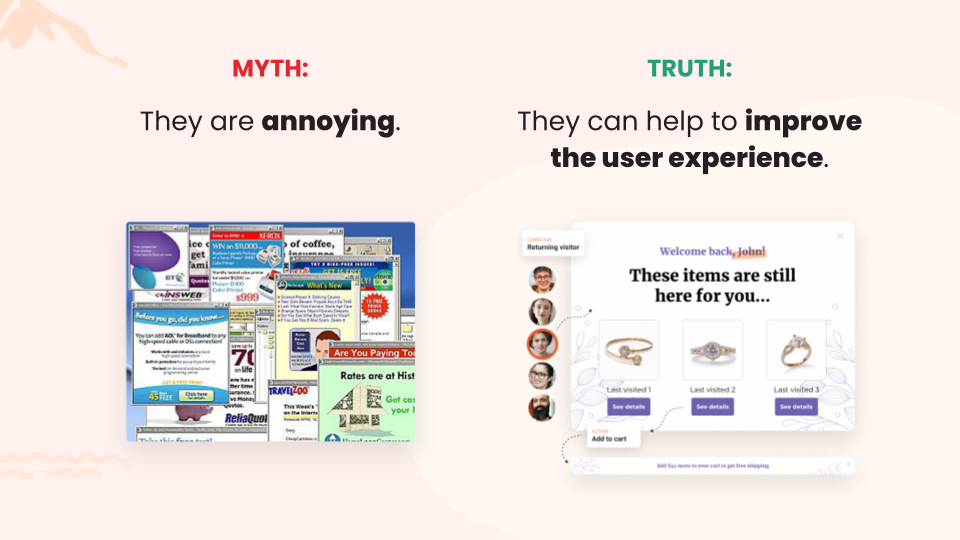
Myth #2: They affect the speed of your website 🚀
Staying on the topic of user experience, many people believe that popups make your website load slower.
But in reality, using popups to simplify the main content and to communicate most of your personalized messages in your popups will help your website load faster. The experienced page load time (EPT) will be smaller too.
Since your popup will load asynchronously, it will not interfere with the Largest Contentful Paint (LCP). This is one of the most important metrics in Web Vitals (an initiative by Google that delivers guidance for quality signals that indicate a “great” site experience).
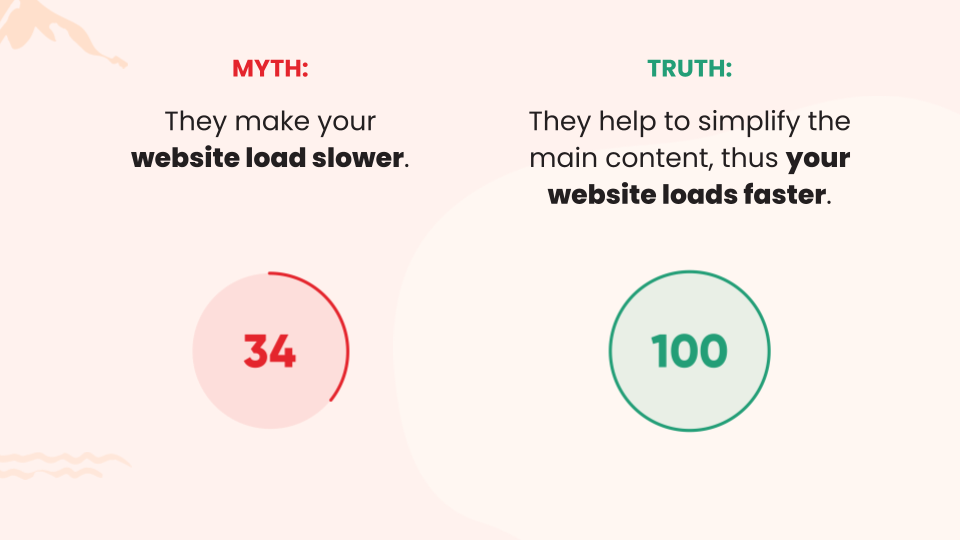
Myth #3: Popups don’t work on mobile 📵
Many people think that popups aren’t well suited for viewing on mobile because of the smaller screen sizes.
However, it actually helps popups to be even more effective. Our analysis on how users interact with OptiMonk popups shows that mobile popups convert 14.47% better than desktop popups!
And it makes sense when you consider that mobile popups draw in people’s attention because they occupy the screen. Mobile users really take in all the information on your popups and consider your messages and offers.
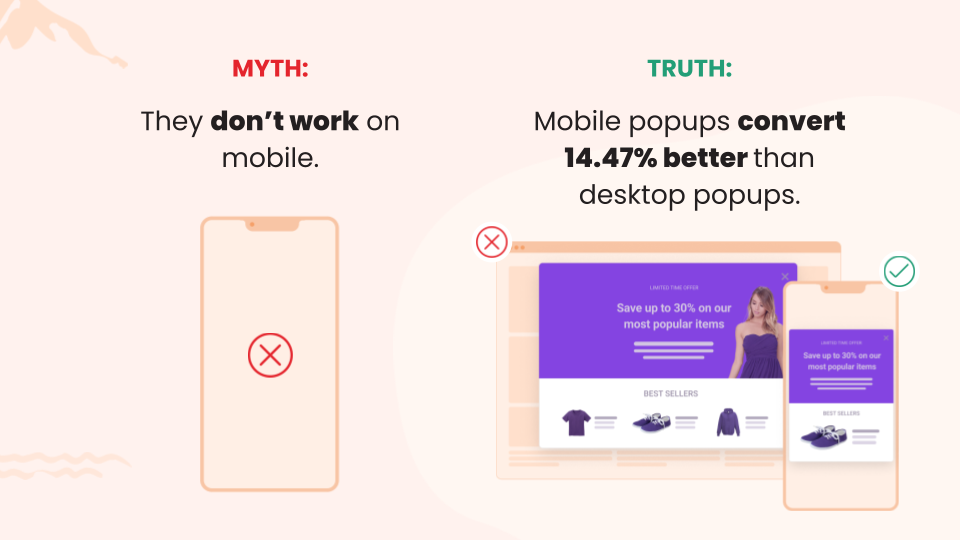
Myth #4: Popups are bad for SEO 👎
This myth has been around for a long time. Since the early 2000s, in fact. Back then, popups were ugly and intrusive—constantly opening up new browser windows.
Today, however, popup tools use overlay technology that makes them appear within the same window. This doesn’t block visitors as previous, old-school popups, and from Google’s perspective, it makes popup content indistinguishable from the rest of your website.
That means that popups won’t affect SEO as long as they’re optimized for speed and mobile viewing (which OptiMonk popups are).
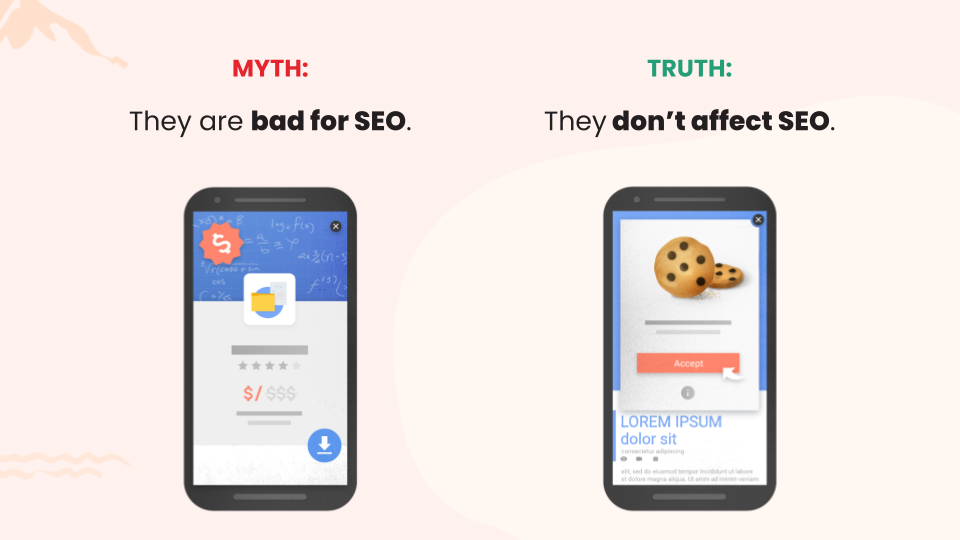
Myth #5: Popups are only good for list building 📧
Most marketers think about popups solely as list-building tools. Yes, popups are great for list-building, but they also have lots of other use-cases that most people don’t know about like:
- Cart abandonment popups can help improve your conversion rate
- Product recommendation popups can increase your average order value
- Popup surveys can generate tons of valuable feedback
These are only a few examples on how popups can improve your customer experience and revenue beyond building your list. You can check out all the use cases in OptiMonk’s Template Library.
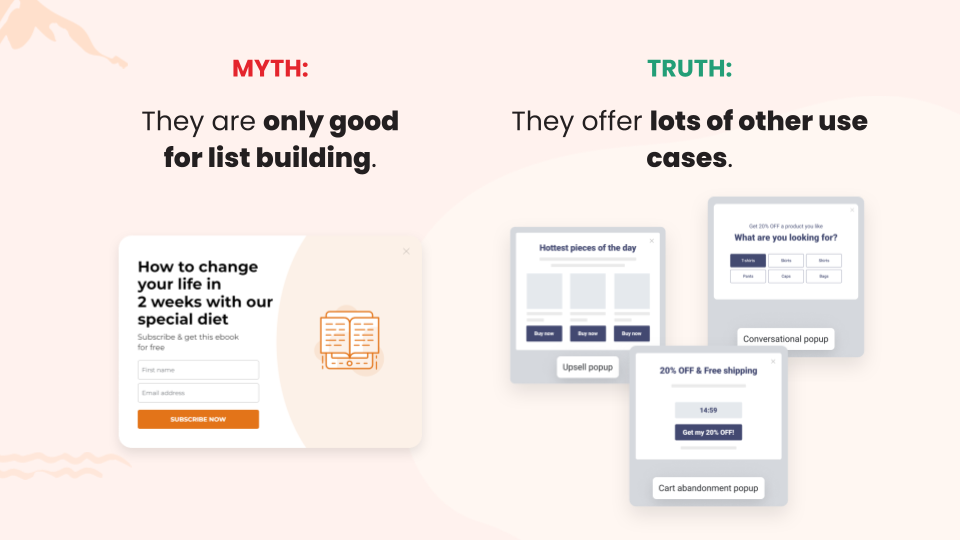
Myth #6: The more aggressive the popup, the more money it earns 💰
This myth is a relic of the old “growth hacking” mindset, which considers improving micro-conversions as the only worthwhile use of popups.
The reality is that website visitors are human. They’re not only highly sensitive to deceitful and exploitative ecommerce tactics, but they’re also really good at noticing them.
Instead of focusing on growing conversions by any means, focusing on value creation is a more holistic approach. It will lead to a better customer experience because you help your customers shop more conveniently and successfully.
You’ll actually convert better with helpful popups and achieve a much higher Customer Lifetime Value at the same time.
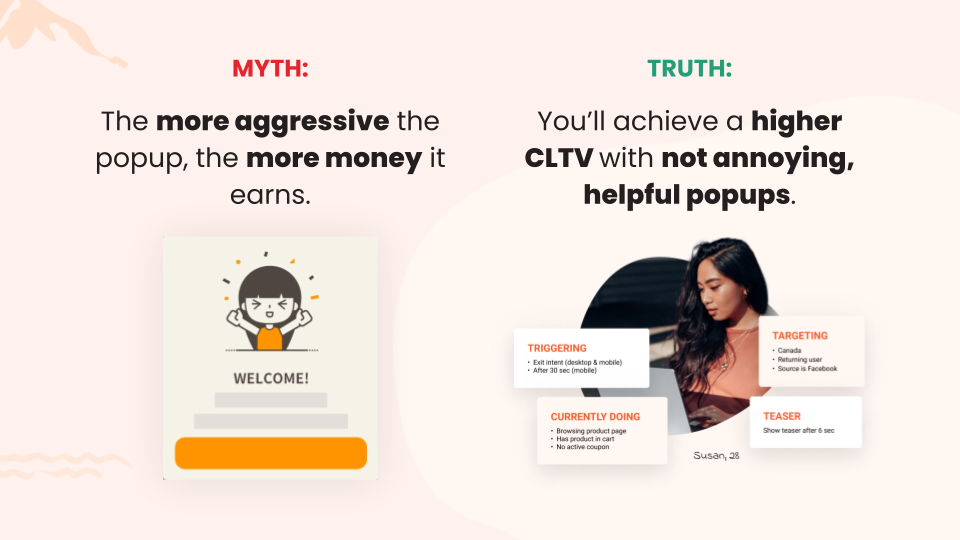
The takeaway
If you’re an ecommerce store owner who doesn’t use popups because you believe in one of these misconceptions, you’re missing out on something great.
I’ve been working together with hundreds of online merchants for eons and personally helped many of our customers to optimize their campaigns. And this experience proves that you can achieve amazing results with the right popups.
If you still have some doubts about using popups, or there’s a myth you’ve heard that I didn’t tackle in this post, share it in the comments and I’d be happy to discuss it with you.
Related articles:
Migration has never been easier
We made switching a no-brainer with our free, white-glove onboarding service so you can get started in the blink of an eye.

What should you do next?
Thanks for reading till the end. Here are 4 ways we can help you grow your business:
Boost conversions with proven use cases
Explore our Use Case Library, filled with actionable personalization examples and step-by-step guides to unlock your website's full potential. Check out Use Case Library
Create a free OptiMonk account
Create a free OptiMonk account and easily get started with popups and conversion rate optimization. Get OptiMonk free
Get advice from a CRO expert
Schedule a personalized discovery call with one of our experts to explore how OptiMonk can help you grow your business. Book a demo
Join our weekly newsletter
Real CRO insights & marketing tips. No fluff. Straight to your inbox. Subscribe now
Csaba Zajdo
- Posted in
- Conversion
Partner with us
- © OptiMonk. All rights reserved!
- Terms of Use
- Privacy Policy
- Cookie Policy













